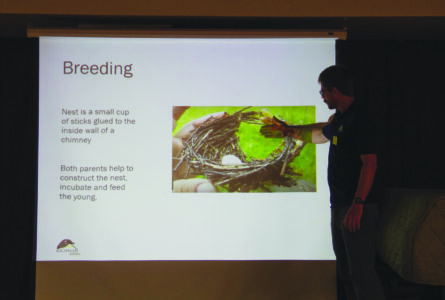Ticks and mosquitoes can pose health risks

R. R. Branstrom | Daily Press When hiking in wooded areas — especially those with damp, shady areas, like Haymeadow Creek in Hiawatha National Forest, pictured above — long pants, long sleeves, bug spray and adhering to trails are recommended to reduce bites from infected ticks and mosquitoes.
ESCANABA — Some of the pesky little critters that emerge this time of year are little more than annoyances. But ticks and mosquitoes pose threats to human health. Diseases carried by both are present in Michigan, and it is important to reduce risk of exposure through preventative measures like using bug spray and maintaining lawns.
According to the Michigan Department of Health and Human Services, there are over 20 known tick species in the state. The most common by far is the American dog tick (also known as a “wood tick”), which bites people and pets, is generally active May through July and can carry Rocky Mountain spotted fever and tularemia. The runner-up is the black-legged tick (“deer tick”), which makes up about 15% of ticks found in Michigan and may carry the bacteria that causes the notorious Lyme disease plus other pathogens, including those that lead to anaplasmosis, babesiosis, deer tick virus and ehrlichiosis. In smaller quantities are the lone star tick, a potential spreader of ehrlichiosis and tularemia that is found in areas with whitetail deer population; the woodchuck tick, which prefers to bite animals and pets but will also bite people and has been known to carry Powassan virus, which can be very serious; and the brown dog tick (“kennel tick”) which can survive and breed both indoors and outdoors and may transmit babesiosis and ehrlichiosis to dogs and Rocky Mountain spotted fever.
Mosquitoes are vectors of West Nile virus, Jamestown Canyon virus, Zika virus, dengue, and Eastern Equine encephalitis. In 2023, 25 human cases of arboviruses (viruses transmitted by mosquitoes and other insects) were reported in Michigan in 2023. 21 were West Nile, with the only human case in the U.P. reported from Ontanogan County. However, mosquitoes and animals with West Nile virus were also identified in Marquette and Chippewa counties.
Some, but not all of the aforementioned afflictions are treatable.
Lyme disease, caused by the bacteria Borrelia burgdorferi and Borrelia mayonii, is characterized by a signature bullseye-like rash and symptoms like fever, headaches and joint and muscle pain, within three to 30 days; other abnormalities like nerve paralysis, arthritis, and arrhythmia may appear months later if the disease goes untreated. However, transmission does not occur until the tick has been attached for over 24 hours, so early removal is key.
Lyme and most of the other tick-borne diseases are treatable with antibiotics like doxycycline. If left unchecked, anaplasmosis — the symptoms of which are fever and chills, muscle aches, nausea, and confusion — can be fatal, but it is also treatable with doxycycline.
Powassan encephalitis, however, is a virus with no cure that can cause inflammation of the brain. Symptoms are treatable, and even the most severe cases have a 90% survival rate.
As with most dangerous things, prevention is ideal. Both ticks and mosquitoes may be repelled by active ingredients DEET, picaridin (also known as icaridin), oil of lemon eucalyptus, para menthane-diol, or IR-3535, according to the Environmental Protection Agency (EPA).
As ticks prefer shady, moist areas, people should try to stay on groomed trails when hiking and avoid overgrown grass and leaf litter. One suggestion to keep ticks from entering yards is to line the property with a three-foot wide boundary of well-sunlit wood chips — it acts as a sort of moat to keep ticks from crossing in from wooded areas.
Mosquitoes breed in areas of stagnant water, so reducing the presence of such trapments will reduce larval populations — and therefore adults and the diseases they carry. It is recommended to drill holes in the bottom of outdoor recycling bins, empty untreated swimming pools regularly, and dispose of things like scrap tires that gather water.
The Public Health Department’s Environmental Health office provides kits containing materials for submitting ticks for identification. They are used to track the presence of various tick species in Michigan, and if black-legged ticks are received alive, they will also be tested for Lyme disease at no charge.
Michigan.gov has further information on emerging tick- and mosquito-borne diseases. The Michigan Mosquito Control Association, a nonprofit that calls mosquitoes “the most medically important insects in Michigan and the entire world,” gathers information on their biology, news, surveillance and control at michiganmosquito.org.



